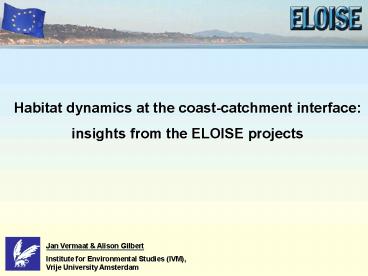Habitat dynamics at the coastcatchment interface: - PowerPoint PPT Presentation
1 / 14
Title:
Habitat dynamics at the coastcatchment interface:
Description:
... turbulence spectra may lead to altered plankton and fish community composition ... altered plankton composition (E) altered plankton com-position (E) ... – PowerPoint PPT presentation
Number of Views:34
Avg rating:3.0/5.0
Title: Habitat dynamics at the coastcatchment interface:
1
Habitat dynamics at the coast-catchment
interface insights from the ELOISE projects
Jan Vermaat Alison Gilbert Institute for
Environmental Studies (IVM), Vrije University
Amsterdam
2
Specific Approach
- Assess contribution of ELOISE projects to
understanding of coastal dynamics. - Habitat? Adhered to EUNIS-typology, but
aggregated these into 8 categories. - Dynamics within (tidal, seasonal,
inter-annual..) and between habitats
(transitions). - Identify societal causes of coastal habitat
change (through aggregate DP-SIR).
3
1. Introduction-ELOISE contributions
4
2. Coastal Habitat Typology (1)
Adhered to EUNIS typology
5
2. Coastal Habitat Typology (2)
Different coastal landscape types have been
identified on the basis of predominant substrate,
slope and prevailing tidal regime.
6
2. Coastal Habitat Typology (3)
- Particular coastal habitats are more prevalent in
particular coastal landscapes. - European seagrass beds can only be found in
unconsolidated sediments. - Stands of macro-algal kelp are abundant on hard
rocks.
- Several habitats have rather similar patterns of
occurrence across landscapes. - E.g. mudflats and sandbars, cliffs and shingle
bars, as well as wetland and dune systems.
- Habitat types differ in their degree of
homogeneity and spatial extent. - E.g. Estuaries and lagoons appear to be rather
generic and actually may comprise complexes of
different, more homogeneous habitat types.
7
3. Natural Dynamics (1)
Dynamics within (tidal, seasonal,
inter-annual..) and between habitats
(transitions).
Changes could be gradual species replacement in a
benthic macrofauna community as a result of
colonisation from the south during prolonged
periods of higher mean annual water temperatures.
Internal dynamics (changes occurring within a
habitat due to internal or external forces, where
the habitat itself remains identifiable).
E.g. the drastic declines in seagrass beds across
Europe. Probably the result of a substantial
change in forcing factors, whether abiotic or
biotic. Giesen et al. (1990), Frederiksen et
al., (2004a)
Transitional dynamics (change into another type
of habitat)
8
3. Natural Dynamics (2)
Summary of both internal and transitional
dynamics
Legend Ttidal S seasonal, Ainterannual CWC
changes in patterns of waves or currents leading
to changed patterns in sedimentation regime CPH
changes in precipitation or hydrology (altered
river discharge)
The interplay of sediment mobility and
colonisation patterns of seagrass often leads to
mosaics of these habitats, often in the form of
wavelike bands. Marba and Duarte (1995),
Frederiksen et al. (2004b).
9
4. Drivers and Pressures (1)
Analysis in 3 parts (a). driving pressures,
(b). environmental state change, (c). expected
consequences for habitat change.
(a). driving pressures
Legend very significant significant, 0
minor to insignificant (loc) locally very
significant.
10
4. Drivers and Pressures (2)
(b). environmental state changes/impacts
Legend very significant significant, 0
minor to insignificant (loc) locally very
significant.
11
4. Drivers and Pressures (3)
(c). consequences for habitat change
See driving pressures table for description of
keywords.
12
5. Conclusions (1)
4 large areas of research identified
- 1. Comparative surveys of spatial pattern
- larger-scale spatial variability such as habitat
mosaics and their spatio-temporal dynamics have
remained poorly investigated. - would enable firmer conclusions on
state-transitions within and among habitat types.
- 2. Fisheries and aquaculture
- effects of aquaculture on coastal foodwebs is not
so well defined. - very relevant in view of the foreseen expansion
of aquaculture into all European seas.
13
5. Conclusions (2)
4 large areas of research identified
- 3. EC-wide stock-taking
- Stock-taking and assessment of habitat areas
covering the coastal zone of Europe has been
imbalanced so far, both with respect to countries
as well as habitats. - Calibration among member countries and discussion
on level of aggregation for EC-wide stock-taking
reviews requires attention and coordination
between EEA, national authorities, and the
coastal research community.
- 4. Disciplinary integration
- stakeholder involvement mechanisms, the roles of
government, institutional organisations, law and
socio-cultural contrasts are worthwhile to be
developed.
14
Key references mentioned
Frederiksen M, Krause-Jensen D, Holmer M, Sund
Laursen J (2004a) Long-term changes in area
distribution of eelgrass (Zostera marina) in
Danish coastal waters. Aquatic Botany 78
167-181. Frederiksen M, Krause-Jensen D, Holmer
M, Sund Laursen J (2004b) Spatial and temporal
variation in eelgrass (Zostera marina)
landscapes influence of physical setting.
Aquatic Botany 78 147-165. Giesen WBJT, Van
Katwijk MM, Den Hartog C (1990) Eelgrass
condition and turbidity in the Dutch Wadden Sea.
Aquatic Botany 37 71-85. Marba N, Duarte CM
(1997) Interannual changes in seagrass (Posidonia
oceanica) growth and environmental change in the
Spanish Mediterranean littoral zone. Limnol
Oceanogr 42 800-810.































